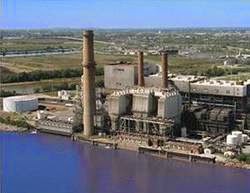Earth Day / "Black Dirt"
Earth Day, April 22, was so close to Easter this year that we weren't able to properly acknowledge it in church. So on Saturday, May 3, we're going to have "Earth Day Morning Prayer," incorporating some of the resources on offer from Earth Ministry. Then we'll proceed outside (weather permitting) to plant the bulbs used to adorn our altars for Easter.
This year's Earth Day got me thinking back again, one of my favorite pastimes. To the left is an undated picture of the Edge Moor Power Plant, located near Wilmington, Delaware, right on the Delaware River. I grew up in the 1950s and 1960s about a mile or so from this bad boy, back in the days when it was coal-fired (in the interest of truth, I should tell you that the parent company announced in 2010 that the plant was converting to natural gas). Practically next-door to it was the Edge Moor Plant, a DuPont facility that made pigment for white paint. That whole part of the riverbank was just industrial heaven, I guess; lots of people were employed there, but both plants spewed out toxins galore into the air and the water. In the 50s and early 60s, of course, nobody cared, even if they knew.
We knew something was in the air, but it never seemed like a big deal. On a mild day, if we opened the windows on the eastern side of the house, the outside windowsills were always covered with what my mother referred to as "black dirt," a coal-black, somewhat greasy, granular powder. "Look at the black dirt today," she would remark. She blamed it on the pigment plant. I think it was the coal-fired power plant that was really to blame.
According to the Center for Media and Democracy's SourceWatch page on the Edge Moor Power Plant, one of the toxins released into the local air we breathed was a soot-like fine particulate:
Fine particle pollution is formed from a combination of soot, acid droplets, and heavy metals formed from sulfur dioxide, nitrogen oxide, and soot. Among those particles, the most dangerous are the smallest (smaller than 2.5 microns), which are so tiny that they can evade the lung's natural defenses, enter the bloodstream, and be transported to vital organs. Impacts are especially severe among the elderly, children, and those with respiratory disease.
Gotta love that soot and acid, not to mention heavy metal. It only hurts when I inhale. But, all kidding aside,
the same page attributes all kinds of woes to the air pollution produced (along with our electricity) by this single power plant. In fact, there's a handy chart:
That's 31 deaths per year, if I read the chart correctly. And that's some serious "black dirt."
This year's Earth Day got me thinking back again, one of my favorite pastimes. To the left is an undated picture of the Edge Moor Power Plant, located near Wilmington, Delaware, right on the Delaware River. I grew up in the 1950s and 1960s about a mile or so from this bad boy, back in the days when it was coal-fired (in the interest of truth, I should tell you that the parent company announced in 2010 that the plant was converting to natural gas). Practically next-door to it was the Edge Moor Plant, a DuPont facility that made pigment for white paint. That whole part of the riverbank was just industrial heaven, I guess; lots of people were employed there, but both plants spewed out toxins galore into the air and the water. In the 50s and early 60s, of course, nobody cared, even if they knew.
We knew something was in the air, but it never seemed like a big deal. On a mild day, if we opened the windows on the eastern side of the house, the outside windowsills were always covered with what my mother referred to as "black dirt," a coal-black, somewhat greasy, granular powder. "Look at the black dirt today," she would remark. She blamed it on the pigment plant. I think it was the coal-fired power plant that was really to blame.
According to the Center for Media and Democracy's SourceWatch page on the Edge Moor Power Plant, one of the toxins released into the local air we breathed was a soot-like fine particulate:
Fine particle pollution is formed from a combination of soot, acid droplets, and heavy metals formed from sulfur dioxide, nitrogen oxide, and soot. Among those particles, the most dangerous are the smallest (smaller than 2.5 microns), which are so tiny that they can evade the lung's natural defenses, enter the bloodstream, and be transported to vital organs. Impacts are especially severe among the elderly, children, and those with respiratory disease.
Gotta love that soot and acid, not to mention heavy metal. It only hurts when I inhale. But, all kidding aside,
the same page attributes all kinds of woes to the air pollution produced (along with our electricity) by this single power plant. In fact, there's a handy chart:
| Type of Impact | Annual Incidence | Valuation |
|---|---|---|
| Deaths | 31 | $230,000,000 |
| Heart attacks | 54 | $6,000,000 |
| Asthma attacks | 510 | $27,000 |
| Hospital admissions | 25 | $580,000 |
| Chronic bronchitis | 19 | $8,500,000 |
| Asthma ER visits | 21 | $8,000 |
That's 31 deaths per year, if I read the chart correctly. And that's some serious "black dirt."
Lots of kids I knew had asthma. A few of my friends' dads died early, of heart ailments. My own parents died of lung problems (both were smokers, of course, as were many people then). But it does make me wonder ...
I want to live in a world with no more "black dirt," I hope that's still possible.

Comments
Fill Dirt for Sale